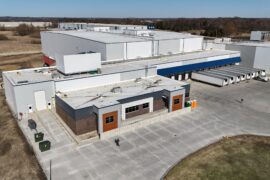12 Months on from Ground Breaking Ceremony sees retail customers CSM move in to new cold store
Less than 12 months since the company’s ground breaking event held in Summer 2012, the first phase of a three part expansion is now complete and in operation at the 13.6 acre site, adjacent to the group’s headquarters in Heywood.
The new cold store, will on completion of all three phases, double Heywood’s existing pallet capacity, from 40,000 to 80,000 sites. The expansion allows the company to create a northern ‘superhub’ where stock will be consolidated for more efficient delivery into the UK’s major retailers and food service organisations.
The shell of the second phase, which has already been built, will be fitted out over the next 6 months and will go live throughout 2014. The final phase will be fitted out as and when required, according to customer demand.
 The new building is super insulated to help reduce energy use making it one of the most energy efficient cold stores in the country. It will also include rainwater harvesting to feed the cooling systems, which will save on fresh water usage. Photovoltaic solar panels and LED lighting have been fitted as Yearsley Logistics continue their focus on reducing our electricity use by 8% by 2015.
The new building is super insulated to help reduce energy use making it one of the most energy efficient cold stores in the country. It will also include rainwater harvesting to feed the cooling systems, which will save on fresh water usage. Photovoltaic solar panels and LED lighting have been fitted as Yearsley Logistics continue their focus on reducing our electricity use by 8% by 2015.
In addition, the cold store will include Yearsley Logistics first PAS system, with half of the cold store fitted with an automated racking system. This in the long term will speed up the customer ordering process and help to improve productivity, as well as having environmental benefits in relation to less door openings and lighting.
Harry Yearsley, managing director said: “This expansion is in direct response to demand from new customers for whom the North West is an ideal location. Our existing Heywood store was running near to capacity and this expansion will amount to a £20m investment in facilities for our customers and also secures jobs for our employees. It is part of our long term plan to consolidate stock in strategically located stores, helping us to increase efficiency, reduce carbon output and better meet the storage needs of manufacturing customers and the delivery requirements of retail and food service customers across the country.”





